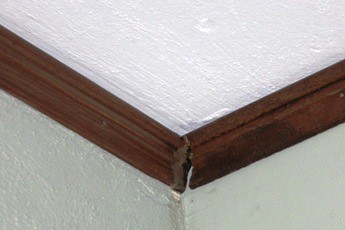You may ask "How did you manage to successfully trim four rooms upstairs with picture rail if you can't cope?" The answer of course, is that I used salvaged rail and made sure to take advantage of the copes that were already cut by people FAR more skilled than I am. It became a challenge in itself to figure out how to take advantage of the copes already cut!
Which leads to trimming the new bump out in the office/spare bedroom. Way back in the 1950's a temporary closet had been built into that space. We ripped it out and put in our chase for the HVAC and electrical to go upstairs. However the picture rail in the corner had already been cut and removed long ago. I had barely enough salvage left to do this last little job, but it meant having to do a cope cut myself, so here it is:

The top fit pretty well, but the bottom has some real issues. You can see that when I put it up into place:

In my defense it doesn't look that bad when you're standing in the room, and that corner is very out of the way. If I slather enough wood filler up there, it will be invisible.
What you may also notice from that last picture is that the original rail was cut short of where the new bump out starts so I was forced to GLUE a tiny block of wood in place to fill that gap. Once I put a little touch up paint over the glue that bubbled out, it too should be invisible. (I hope!)
 Here is a record of our restoration of a 1928 craftsman. We will be the second family to live in the home. Watch our progress when we prevail and our privation and pratfalls as we do not.
Here is a record of our restoration of a 1928 craftsman. We will be the second family to live in the home. Watch our progress when we prevail and our privation and pratfalls as we do not.

3 comments:
The thought of coping the inside & outside corners in my kitchen gave me stomach aches, so I'm paying the carpenter that built my cabinet to come back & do them for me :-) I'm a wimp, I know.
Coping really isn't too bad once you get the hang of it. The trick is to first make a 45 degree cut (as for an inside, not an outside corner) on the end you are going to cope. Then use the resulting line on the face profile as your guide. Use rasps to fine-tune the fit. The biggest challenge is that not every profile on each piece matches exactly even using modern milled lumber.
As someone who has issues cutting a straight line with a paper cutter, I feel your pain.
I'd suggest getting whatever fancy tools you need to properly scribe the exact right line on the piece to be cut. Then, cut whatever straight cuts may be present. Cope the rest of it very rough, leavnig plenty of space. Use some very aggressive files to get it down to the profile you want. You'll have more control with the files.
Post a Comment